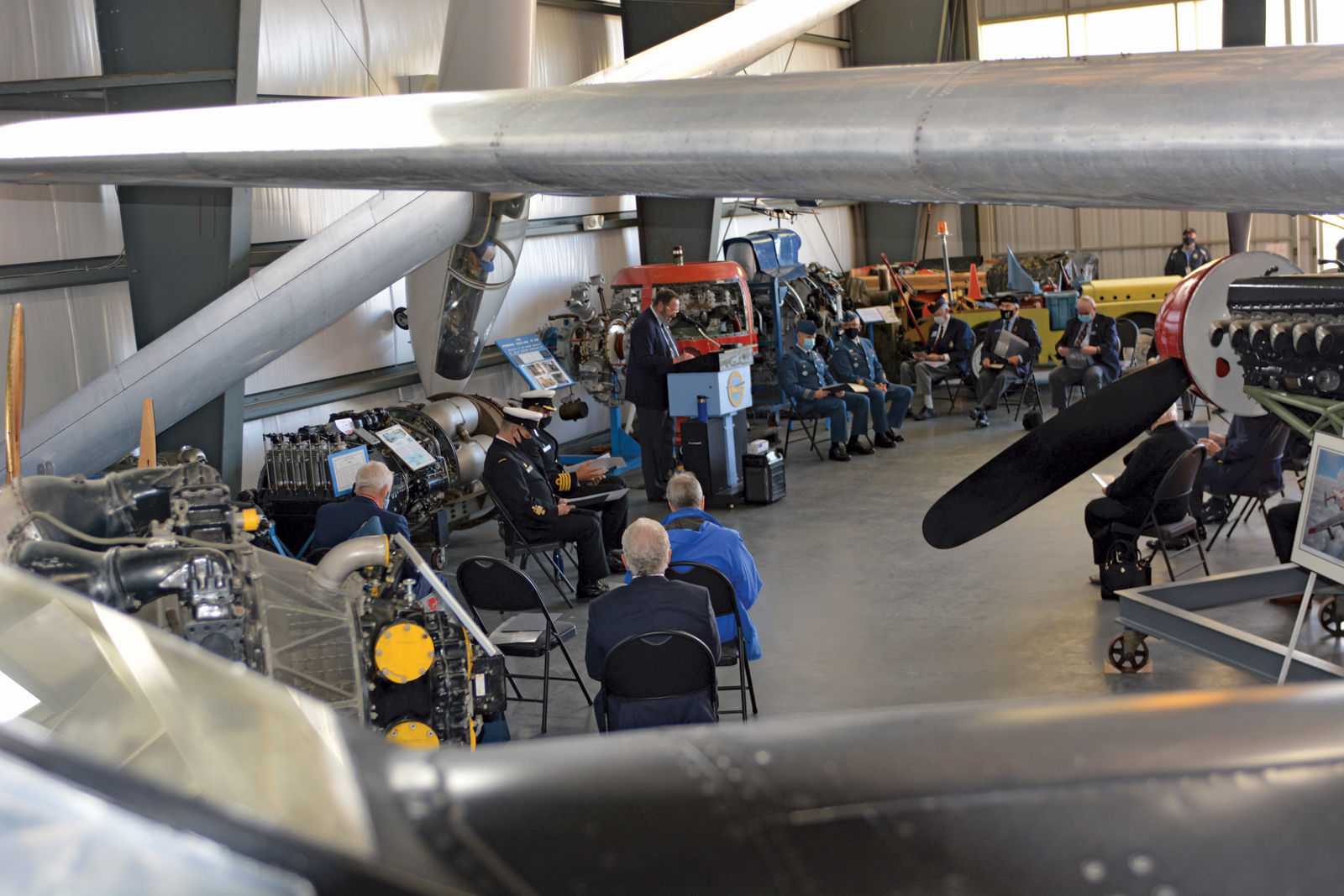Monumental flight marked 100 years later
By Lookout on Oct 26, 2020 with Comments 0

Military members past and present, following health and safety protocols, gathered at the B.C. Aviation Museum for a ceremony to commemorate the 100th anniversary of first trans-Canada flight. Photo by CFB Esquimalt Base Public Affairs
Peter Mallett
Staff Writer
––
A small ceremony at Victoria International Airport on Oct. 21 marked a monumental moment in Canadian aviation history.
The commemorative event at the B.C. Aviation Museum was the final event celebrating the 100th anniversary of the first trans-Canada flight. The historical flight involved a group of military aviators completing a 10-day journey through relays from Dartmouth, N.S., to Vancouver, B.C., making multiple planned and unplanned stops along the way.
Retired navy Captain Kevin Carlé helped organize the commemorative ceremony in Victoria. Due to COVID-19 physical distancing measures, the event could only involve 25 military personnel, veterans, and museum staff. Those attending the ceremony included Capt(N) Sam Sader, Base Commander, and military personnel from 443 Maritime Helicopter Squadron.
“Hosting this event was a great opportunity to pay tribute to this fantastic but relatively unknown historic event,” said Carlé. “Communication and transportation helped build this country and the whole purpose of this flight was to convince people, especially politicians of the day of the importance of the robust aviation capability of Canada.”
Their Journey
The first legs of the flight used seaplanes and flying boats donated by the British Air Ministry and took off from the Canadian Air Board Station (present day 12 Wing Shearwater) on Oct. 7, 1920, at 8 a.m.
The final legs of the journey from Winnipeg to the West Coast commenced in the early morning hours of Oct. 11 and involved the relay of three DeHavilland DH 9A single engine biplanes. After taking off from Calgary on Oct. 13 and crossing the Rocky Mountains, the flight crew touched down at Minoru Park racetrack in Richmond, B.C., near Vancouver at 11:25 a.m. on Oct 17.
It was an arduous journey for all of flight crews involved. Pilots often flew in open cockpits, braved extreme weather conditions that forced multiple delays, and through Western Canada were forced to follow the tracks of the Canadian National Railway and prominent geographical landmarks to navigate and find their way.
The trans-Canada flight was organized and executed by the Canadian Air Board, a short-lived department of the Dominion of Canada Government responsible for the development of Canadian aviation, both civil and military in the aftermath of the First World War.
Following a celebratory dinner in Vancouver, after the flight crew’s arrival, they eventually carried on to Esquimalt in a Curtiss HS-2L patrol flying boat. The unexpected flight to Vancouver Island came at the encouragement of Norman Yarrow, general manager of Yarrows Shipyard in Esquimalt and vice-president of the British Columbia Advisory Air Council.
Their new goal was to personally present letters that had been hand-carried across the country from the Lieutenant Governors of Nova Scotia, Manitoba, and Saskatchewan to the Lieutenant-Governor of British Columbia Edward Gawler Prior.
Although the flight crew lost their way in dense fog and were forced to spend the night on San Juan Island, Washington, they fulfilled Yarrow’s wishes the following day.
A Point to Prove
Aviation historian, Col (Retired) John L. Orr helped organize a ceremony at Shearwater Aviation Museum on Oct. 7 to commemorate the launch of the trans-Canada flight and has researched the accomplishment extensively.
Orr says the trans-Canada flight was not only significant because it was a first and proved that mail could be delivered by air across the country, but also because it was critical to the survival of Canada’s fledgling aviation industry itself.
“The Air Board’s purpose in conducting the transcontinental flight was to demonstrate the utility of aviation to the public, but more importantly to Canadian politicians,” said Orr. “Not incidentally, it was also an account of guts and determination as a small group of aviators battled the elements in an open-cockpit aircraft and blazed a trail across the country.”
For a detailed historical account of the flight visit the website of the Shearwater aviation museum at www.shearwateraviationmuseum.ns.ca
––––
Filed Under: Top Stories
About the Author:





